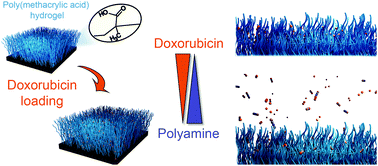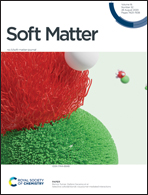Triggering doxorubicin release from responsive hydrogel films by polyamine uptake†
Abstract
Polyamines such as putrescine, spermidine and spermine are required in many inter- and intra-cellular processes. There is, however, evidence of anomalously high concentrations of these polyamines around cancer cells. Furthermore, high polyamine concentrations play a key role in accelerating the speed of cancer proliferation. Some current therapies target the reduction of the polyamine concentration to delay the cancer advance. In this study, we use a molecular theory to prove the concept that poly(methacrylic acid) (PMAA) hydrogels can play the dual role of incorporating and retaining polyamines as well as releasing preloaded drugs in response. Towards such a goal, we have developed a molecular model for each of the chemical species, which includes the shape, size, charge, protonation state, and configuration. Our results indicate that PMAA hydrogel films can incorporate significant amounts of polyamines; this absorption increases with the solution concentration of the polyamines. Doxorubicin was chosen as a model drug for this study, which can be successfully incorporated within the film; the optimal encapsulation conditions occur at low salt concentrations and pH values near neutral. Polyamine absorption within the film results in the desorption of the drug from the hydrogel. An increase in the concentration of the polyamines enhances the drug release. To validate our theoretical findings, poly(methacrylic acid) hydrogel thin films were synthesized by atom transfer radical polymerization. Absorption/desorption experiments followed by UV-Vis spectroscopy demonstrate doxorubicin encapsulation within these films and polyamine-dependent drug release.



 Please wait while we load your content...
Please wait while we load your content...